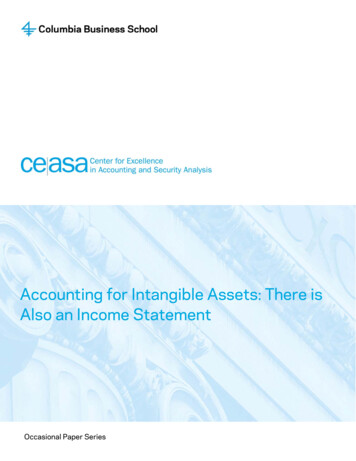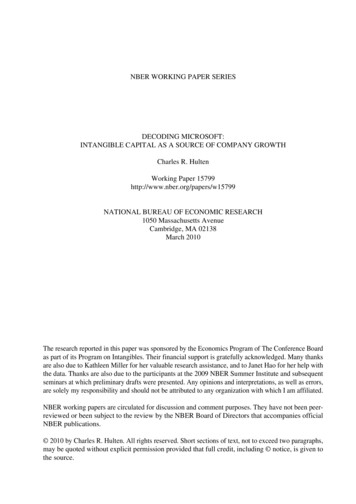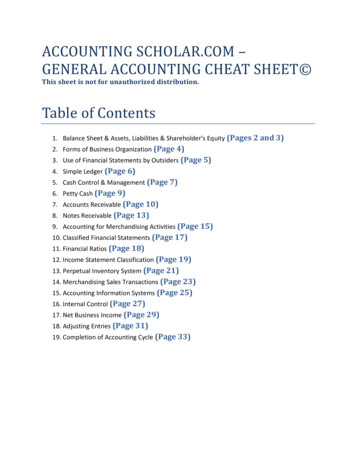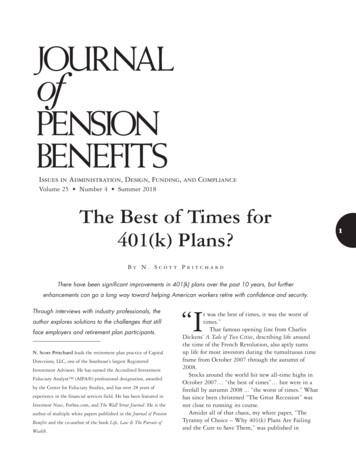
Transcription
Accounting for Intangible Assets: There isAlso an Income StatementOccasional Paper Series
Center for Excellence in Accounting & Security AnalysisColumbia Business School established the Center for Excellence in Accounting and Security Analysisin 2003 under the direction of Professors Trevor Harris and Stephen Penman. The Center (“CEASA”)aims to be a leading voice for independent, practical solutions for financial reporting and securityanalysis, promoting financial reporting that reflects economic reality and encouraging investmentpractices that communicate sound valuations.CEASA’s mission is to develop workable solutions to issues in financial reporting and accountingpolicy; produce a core set of principles for equity analysis; collect and synthesize best thinking andbest practices; disseminate ideas to regulators, analysts, investors, accountants and management; andpromote sound research on relevant issues. Drawing on the wisdom of leading experts in academia,industry and government, the Center produces sound research and identifies best practices on relevantissues. CEASA's guiding criterion is to serve the public interest by supporting the integrity of financialreporting and the efficiency of capital markets.Located in a leading university with a mandate for independent research, CEASA is positioned to leada discussion of issues, with an emphasis on sound conceptual thinking and without obstacles ofconstituency positions.More information and access to current research is available on our website athttp://www.gsb.columbia.edu/ceasaThe Center is supported by our generous sponsors: General Electric, IBM and Morgan Stanley. Wegratefully acknowledge the support of these organizations that recognize the need for this center.
Accounting for Intangible Assets: There is Alsoan Income StatementStephen H. Penman; George O. May Professor, Columbia BusinessSchoolJune 2009This paper will be published in a forthcoming issue of Abacus.This paper does not necessarily reflect the views of the Center’s Advisory Board or the Center’ssponsors.
Table of ContentsOVERVIEW .IINTRODUCTION . 1PRELIMINARY POINTS . 2MAIN POINT: THERE IS ALSO AN INCOME STATEMENT . 4THE INCOME STATEMENT MITIGATES POOR BALANCE SHEETS . 6CAN THE BALANCE SHEET MITIGATE POOR INCOME STATEMENTS? . 8HANDLING INTANGIBLE ASSETS WITH ACCOUNTING INFORMATION . 12A.B.MICROSOFT CORPORATION . 12DELL, INC. . 13CONCLUSION . 17REFERENCES . 19
OverviewAccounting is often criticized for omitting intangible assets from the balance sheet. With value in firms of todayflowing less from tangibles assets and more from so-called intangibles – brands, distribution systems, supplychains, “knowledge capital,” “organization capital” – accounting is seen as remiss, with high price-to-bookratios as evidence. The remedy often proposed involves booking these intangible assets to the balance sheet.This paper makes the point that accounting is not necessarily deficient in omitting intangible assets fromthe balance sheet: there is also an income statement, and the value of intangible (and other) assets can beascertained from the income statement. For example, although The Coca-Cola Company does not report itsbrand asset on its balance sheet (and trades about five time book value), earnings from the brand flows throughits income statement. Thus the firm is readily valued from its earnings; the income statement remedies thedeficiency in the balance sheet. Accordingly, accounting that calls for the recognition of “intangible assets” onthe balance sheet may be misconceived.The paper explores the case where the income statement perfectly corrects for a deficient balance sheet,and the case where it does not. It then explores whether, in the latter case, accounting in the balance sheet – bycapitalization and amortization of intangible assets or carrying them at fair value – could remedy the deficiencyin the income statement (or makes it worse). The investigation involves an analysis and valuation of MicrosoftCorporation and Dell, Inc., two companies presumed to possess a good deal of “intangibles assets.”The paper is instructive, not only to those concerned with accounting issues, but also to analystsattempting to value firms with assets missing from the balance sheet. It shows how to handle the accountinginformation in valuation and how to deal with the perceived deficiencies, real or imagined, with respect tointangible assets. In the case of Microsoft and Dell, the reader can observe at how close one comes to theirmarket valuation by using valuation techniques that use accounting information currently provided by GAAP.Center for Excellence in Accounting & Security Analysis i
IntroductionMany commentators view the omission of “intangible assets” from balance sheets as a glaring deficiency. Theyask: How can accountants report a balance sheet that omits important assets like brands, distribution and supplychains, knowledge, human capital, and organization capital, particularly when value in modern firms comesmore from these assets than from the tangible assets on the balance sheet? The complaint reached a crescendoduring the 1990s as technology and internet firms identified with these types of “assets” came to the marketwith high price-to-book ratios that were attributed to missing assets on the balance sheet. While a diminuendofollowed as the perceived intangible assets for many of these firms seemingly evaporated, the accounting forintangible assets continues as a significant research area. Indeed, the current trend towards booking more valueto the balance sheet with fair value accounting involves many of the same issues.This paper provides a perspective that I hope is not only helpful to those grappling with accountingissues but also to analysts who use financial statements to value firms with so-called intangible assets. The mainpoint of the paper simply reminds us that accounting reports not only a balance sheet but also an incomestatement. The value of assets can be ascertained from the income statement as well as a balance sheet, so theissue of accounting for intangible assets is not necessarily a balance sheet problem. Indeed, there is noaccounting problem if the income statement informs about the value. If it does so imperfectly, the researchquestion involves asking if and how accounting for intangible assets in the balance sheet can ameliorate theproblem. Calls for recognition of intangible assets on balance sheets may be misconceived; they fail tounderstand the structure of accounting under which articulated income statements and balance sheets worktogether to indicate firm value, and each statement can correct for the deficiencies in the other.Before expanding on this theme, the paper makes a number of preliminary points that bear on howaccounting might handle intangible assets.Center for Excellence in Accounting & Security Analysis1
Preliminary Points1. “Intangible asset” is a speculative notion. Intangible assets differ from tangible assets not just because theylack physical appearance but also because they are not identifiable such that contracts can be written on themfor delivery. Explicit legal rights like patents and copyrights, and possibly brands, are exceptions (and these arebooked to the balance sheet if purchased, as with any other asset), but “customer relationships,” “organizationcapital,” “knowledge assets,” “human capital,” and the like, are not specific enough for a market price ever beobserved for them. A conjectured value of a conjectured asset that can never be validated with a market price isinherently speculative; value is in the mind of the beholder. This was so for the “intangible assets” conjecturedin the 1990s bubble for which there was no subsequent manifestation. Accounting runs into trouble whenspeculative, conjectured values enter the financial statements, more so when the asset’s existence itself isconjectural. Indeed, the term, “intangible asset” can just be a cover for speculation or even fantasy; theexistence of assets can be promoted simply by developing attractive language.In the speculative 1920s, accountants wrote up asset values in balance sheets for perceived value, butwoke to the crash of 1929 accused of “putting water in the balance sheet.” The subsequent creation of theSecurities and Exchange Commission in the United States led to a 60 year regime where such accounting was ano-no. This outlook was reinforced by fundamental analysts of the time, Benjamin Graham and his adherents.Graham followed a dictum in investing: separate what you know from speculation and anchor on what youknow. To the accountants: Don’t put speculation into the financial statements; tell me what you know – what Ican anchor on – but leave the speculation to me, the analyst. The accountant reports what he or she knows fromtransactions: if an (intangible) asset is identified in a transaction, book it, but do not book it in response tospeculation about its existence.History repeats. In the speculative 1990s, traditional accounting – derided as accounting “for theindustrial age” where value was said to have come from tangible assets – came under challenge, accused offailing to adapt to the “information age” (where value is said to come from intangible assets). But this timeaccounting authorities largely stood firm against water in the balance sheet. With the bursting of the 1990sbubble and the erosion of market value attributed to intangible assets, “industrial age accounting” now lookssensible; waiting until a firm makes a sale to add value to the balance sheet is not such a bad idea after all. It’swhat we know, as evidence of value. (The point should be considered by those advocating more fair valueaccounting in the balance sheet.)Center for Excellence in Accounting & Security Analysis 2
Those who advocated intangible asset accounting in the 1990s often referred to the high price-to-bookratios as justification. Graham, I think, would turn in his grave. For the fundamentalist, accounting serves toinform about the prices of firms. It should be developed independently of prices, not inferred from prices. Onlythen can accounting challenge prices. In the fundamentalists’ view, accounting should challenge entrepreneurs,management, and analysts who claim that firms possess intangible assets.2. “Intangible assets” involve using assets jointly. Most intangible assets are not stand-alone assets that can bevalued on a balance sheet independently of other assets; rather, their value comes from producing cash flowstreams jointly with other assets. Brands, distribution networks, and customer relationships work together toproduce value at the Coca Cola Company, and they cannot work without tangible assets such as delivery trucksand bottling plants. “Knowledge capital” is employed with productive processes, marketing, and management,and cannot work without tangible assets. “Organization capital” involves the organization of assets to be usedjointly. Indeed, it is the firm that is the asset; the firm is an organization of assets designed to gain competitiveadvantage, and the entrepreneurial idea that translates to a business plan for organizing the assets is the sourceof value. Listing an intangible asset on a balance sheet as separately identified is suspect, let alone putting aseparate dollar number on it.The point, of course, applies to all assets on the balance sheet apart from those (like cash and near-cashassets) with separable value (whose liquidation does not affect the value of the remaining assets). Totalingdollar numbers for assets separately listed (“total assets”) cannot report joint value. The balance sheet is not aplace to report the value of intangible assets or indeed tangible assets.1 Recording intangible assets at historicalcost, as with tangible assets, is an open issue to which we will return.1The statement implicitly criticizes fair value accounting for non-separable individual assets and liabilities that are used jointly. But italso provides an explanation of why separable assets, like marketable securities, could be fair valued. See CEASA’s White Paper No.2, Nissim and Penman (2008) for elaboration.Center for Excellence in Accounting & Security Analysis 3
Main Point: There is also an Income StatementIf it is impossible to get a summary value number from the balance sheet, is accounting information hopelessfor inferring the value of intangible assets? No; there is also an income statement. Even though intangible assetsare missing from the balance sheet, earnings from intangible assets flow through the income statement. Valuecan be established by measuring the asset value directly but also by capitalizing the earnings from the asset. Forexample, the value of a stand-alone rental building can be ascertained from the market price of the building (astock valuation) or from the rents that the business yields (a flow valuation). Wh
in the income statement (or makes it worse). The investigation involves an analysis and valuation of Microsoft Corporation and Dell, Inc., two companies presumed to possess a good deal of “intangibles assets.” The paper is instructive, not only to those concerned with accounting issues, but also to analysts











